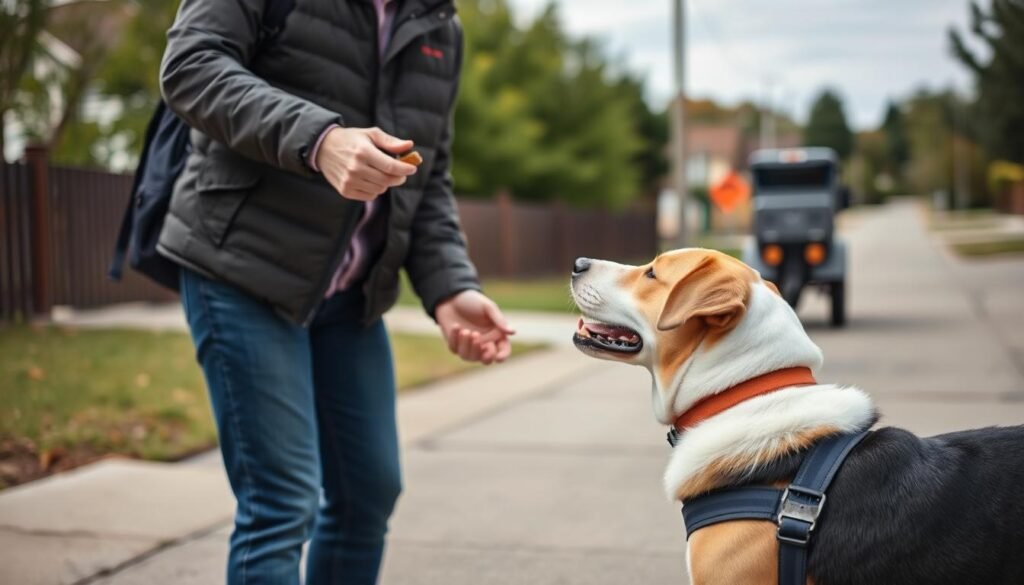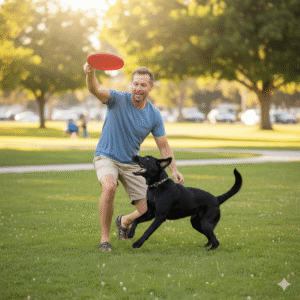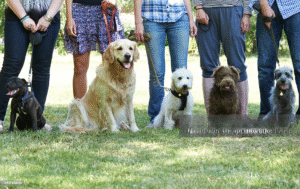Understanding Why Dogs Bark
Before diving into solutions, it’s crucial to understand that barking is a natural form of canine communication. Dogs bark for many different reasons, and identifying the specific trigger for your dog’s vocalization is the first step toward addressing it effectively.
Common Barking Triggers
- Territorial/Protective: When someone approaches your home or yard
- Alarm/Fear: Response to startling sights or sounds
- Attention-Seeking: When your dog wants food, play, or affection
- Boredom/Loneliness: Lack of physical or mental stimulation
- Greeting: Excitement when seeing people or other animals
- Separation Anxiety: Distress when left alone
- Compulsive Barking: Repetitive barking with no clear purpose

Take a moment to observe your dog’s barking patterns. Does it happen at specific times? Is there a consistent trigger? Understanding the “why” behind your dog’s barking is essential for choosing the right solution.
Method 1: Positive Reinforcement Training
Positive reinforcement is one of the most effective and humane approaches to modify any dog behavior, including excessive barking. This method rewards your dog for desired behaviors rather than punishing unwanted ones.

Clicker Training for Quiet Behavior
Clicker training creates a clear connection between the desired behavior (being quiet) and the reward. The click sound marks the exact moment your dog does something right.
- Get a clicker and small, high-value treats your dog loves.
- When your dog is barking, wait for a brief pause (even just a second of quiet).
- The moment your dog stops barking, immediately click and give a treat.
- Gradually extend the duration of quiet time required before clicking and treating.
- Add a verbal cue like “quiet” just before your dog would naturally stop barking.
Sample Daily Training Routine
| Time | Activity | Duration | Goal |
| Morning | Quiet training before walks | 5 minutes | Associate calmness with going outside |
| Mid-day | Doorbell desensitization | 10 minutes | Reduce barking at visitors |
| Evening | Quiet command practice | 5-10 minutes | Reinforce quiet behavior |
Consistency is key with positive reinforcement. Practice daily in short sessions, and make sure everyone in your household follows the same approach. Within a few weeks, most dogs begin to understand that being quiet earns rewards.
Method 2: The Quiet Command Technique
Teaching your dog a specific “quiet” command gives you a tool to interrupt barking episodes. This method builds on positive reinforcement but adds a verbal cue that eventually allows you to stop barking on command.
Step-by-Step Implementation
- Allow your dog to bark 3-4 times when triggered.
- Calmly say “Quiet” in a firm but not angry voice.
- Hold a high-value treat in front of your dog’s nose.
- When your dog stops barking to sniff the treat, wait 2 seconds.
- If they remain quiet, give the treat and praise.
- Repeat this process, gradually increasing the time between the quiet behavior and the reward.
- Practice in different locations and with various barking triggers.

Do’s and Don’ts of the Quiet Command
Do:
- Use a consistent command word
- Speak calmly and clearly
- Reward immediately when your dog complies
- Practice when your dog is calm, not just during barking episodes
- Be patient – this takes time to master
Don’t:
- Yell or sound angry when giving the command
- Reward too late after quiet behavior
- Give up after a few unsuccessful attempts
- Use different words for the same command
- Punish your dog for not understanding
Many owners make the mistake of inadvertently reinforcing barking by giving attention (even negative attention) when their dog barks. Remember that to your dog, any attention can be rewarding. Only reward quiet behavior to avoid sending mixed signals.
Method 3: Environmental Management
Sometimes the simplest way to reduce barking is to manage your dog’s environment. By limiting exposure to barking triggers or creating a more calming atmosphere, you can significantly decrease unwanted barking.

Effective Environmental Modifications
Visual Barriers
For dogs that bark at passing people or animals, installing privacy film on windows can block these visual triggers. The film allows light in while preventing your dog from seeing outside stimuli.
Installation tip: Apply to the lower portion of windows where your dog typically looks out.
Sound Management
White noise machines can mask outside sounds that trigger barking. Consider the Yogasleep Dohm Classic Sound Machine, which creates a consistent background noise that drowns out triggers.
Placement tip: Position near windows or doors where outside noises enter.
Interactive Toys
Puzzle toys and treat-dispensing devices keep your dog mentally engaged and less likely to bark out of boredom. Try Kong toys filled with frozen peanut butter for long-lasting distraction.
Usage tip: Rotate toys regularly to maintain interest.
Environmental management works best when combined with training methods. While these modifications can reduce barking triggers, they should be viewed as tools to help your training efforts succeed rather than standalone solutions.
Method 4: Addressing Root Causes of Barking
For long-term success, it’s essential to address the underlying reasons why your dog barks excessively. Different types of barking require different approaches.

Separation Anxiety Solutions
Dogs with separation anxiety bark excessively when left alone due to genuine distress. This requires a comprehensive approach:
- Gradual desensitization: Practice leaving for progressively longer periods, starting with just seconds.
- Departure cues: Break the association between cues (like grabbing keys) and your departure by doing these things randomly without leaving.
- Comfort item: Leave an article of clothing with your scent to comfort your dog.
- Safe space: Create a comfortable area where your dog feels secure when alone.
- Calming supplements: Consider vet-approved calming aids for severe cases.
Boredom Busters
Dogs often bark simply because they’re bored and under-stimulated. Mental exercise can be as important as physical exercise:
- Daily walks: Aim for at least 30 minutes twice daily.
- Training sessions: 10-15 minutes of learning new tricks provides mental stimulation.
- Scent games: Hide treats around your home for your dog to find.
- Puzzle toys: Invest in toys that make your dog work for treats.
- Doggy playdates: Social interaction with other dogs can reduce boredom.

Health Check Reminders
Sometimes excessive barking can indicate a medical issue. Consider a veterinary check-up if:
- The barking started suddenly without environmental changes
- Your senior dog has begun barking more, especially at night (could indicate cognitive decline)
- The barking is accompanied by other behavioral changes
- Your dog seems to be in pain or discomfort
- The barking pattern is unusual for your dog’s personality
Addressing these root causes often resolves barking issues more effectively than treating the barking itself as the problem. Remember that your dog isn’t barking to annoy you—they’re trying to communicate something important from their perspective.
Method 5: Consistency and Household Training
One of the most common reasons training fails is inconsistency among family members. When one person allows barking while another discourages it, your dog receives mixed messages that create confusion rather than learning.

Creating a Household Training Plan
| Barking Scenario | Agreed Response | What Not To Do |
| Doorbell rings | Everyone uses “quiet” command and rewards silence | One person scolds while another allows barking |
| Barking for attention | Everyone ignores barking, rewards quiet | Some family members give attention during barking |
| Barking at window | Everyone redirects to a place command | Inconsistent responses to the same trigger |
Hold a family meeting to ensure everyone understands and commits to the training approach. Create simple, clear rules that everyone can follow, and consider posting reminder notes near common barking areas like the front door or windows.
Consistency extends beyond people to include environments and situations. Your dog should learn that the rules about barking apply everywhere—at home, in the car, at the park, and in other people’s homes.
Method 6: The “Place” Command Technique
Teaching your dog a solid “place” or “go to your spot” command gives them a clear alternative behavior when barking triggers occur. This technique is especially effective for territorial barking at doors or windows.

Training the Place Command
- Select a specific spot for your dog—a mat, bed, or designated area that’s visible from common barking locations.
- Begin training by saying “place” or “spot” and guiding your dog to the location.
- Reward generously when they reach the spot.
- Add duration by asking them to stay, gradually increasing from seconds to minutes.
- Practice with distractions, starting small and working up to doorbell rings or knocks.
- When barking triggers occur, calmly direct your dog to their place.
- Reward heavily for going to the spot instead of barking.
The beauty of the place command is that it gives your dog a clear alternative behavior that’s incompatible with running to the window or door to bark. With practice, many dogs will automatically go to their place when they hear triggers, bypassing the barking response entirely.
Method 7: Desensitization and Counterconditioning
For dogs that bark reactively to specific triggers like other dogs, strangers, or noises, desensitization and counterconditioning can change their emotional response to these stimuli.

The Desensitization Process
- Identify the trigger that causes your dog to bark (people walking by, doorbells, other dogs).
- Create a controlled version of the trigger at a low intensity (play doorbell sounds quietly, have a friend walk by at a distance).
- Keep your dog under threshold – close enough to notice the trigger but not so close they bark.
- Pair the trigger with treats or something your dog loves.
- Gradually increase the intensity of the trigger as your dog remains calm.
- Practice regularly in short sessions (5-10 minutes).
- Be patient – this process can take weeks or months depending on your dog’s sensitivity.
The goal is to change your dog’s emotional association with the trigger from “threat/excitement” to “predictor of good things.” Over time, your dog will see the mailman and look to you for a treat instead of barking.
Professional Solution: When You Need Faster Results
While the methods above are effective with consistency and time, some situations call for additional help—especially when barking is causing neighborhood complaints or affecting your quality of life.
Introducing a sample training Strategy: Trainer-Recommended Bark Control
The training Strategy uses advanced sound technology that’s safe, humane, and effective for reducing problem barking in as little as 7 days. Unlike basic training that can take weeks or months to show results, this trainer-developed solution works with your dog’s natural learning patterns to quickly establish quieter behavior.
| Traditional Training | BarkStop Pro Solution |
| Takes weeks or months for results | Shows improvement in days |
| Requires constant owner presence | Works even when you’re not home |
| Inconsistent results with multiple family members | Provides consistent response every time |
| Limited effectiveness for some barking types | Works for territorial, attention, and alarm barking |
“After trying everything for my Beagle’s non-stop barking, the course was the breakthrough we needed. Within a week, his barking reduced by 80%, and our neighbors finally stopped complaining.” – Maria T., Verified Customer
LIMITED TIME OFFER: Get 15% off your Strategy today with free shipping! 60-day money-back guarantee if you don’t see improvement in your dog’s barking.
Get Your Training Strategy Today
How It Complements Your Training Efforts
The Training Strategy isn’t meant to replace training—it enhances it. While you work on the fundamental methods we’ve covered, this solution provides immediate feedback to your dog when you can’t be there to guide them. Many professional trainers recommend using such devices as part of a comprehensive approach to problem barking.
For best results, combine the Training Strategy with the positive reinforcement methods outlined above. This two-pronged approach addresses both the immediate behavior and the underlying causes of excessive barking.
Conclusion: Creating a Peaceful Home
Excessive dog barking doesn’t have to be a permanent fixture in your home. With the right combination of understanding, training, and tools, you can significantly reduce problem barking and restore peace to your household.
Key Takeaways
- Understand why your dog barks before choosing a solution
- Positive reinforcement is more effective than punishment
- Consistency across all family members is crucial
- Environmental management can reduce barking triggers
- Address root causes like anxiety or boredom for lasting results
- Consider the Training Strategy for faster results alongside training

Remember that barking is normal dog behavior—the goal isn’t to eliminate it completely but to bring it to a manageable level that works for your household. Be patient with your furry friend as they learn new habits, and celebrate small improvements along the way.
For those situations where you need results more quickly or when traditional methods aren’t enough, the offers a humane, effective solution that thousands of dog owners have used successfully. Whatever approach you choose, your commitment to addressing the barking shows how much you care about your dog’s wellbeing and your shared home environment.






















One Response